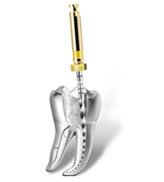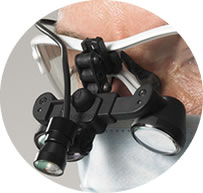Root canal treatment
Rubber dam to prevent bacterial infection
We use rubber dam for treatment in an effort to focus on root canal treatment. Rubber dam is the mask made of rubber which exposes only treated tooth to prevent saliva and bacteria from entering treated area. There are various bacteria in saliva. If saliva enters into nerve and bone of root canal during treatment, infection may occur.

Therefore, aseptic manipulation during root canal treatment is very important. As well as sterilizing instrument, preventing scatter of saliva and blood is essential for preventing infection. Root canal treatment without rubber dam increases the probability of bacterial infection and retreatment may be needed. Wearing rubber dam keeps mouth sterile avoiding saliva and bacteria from tooth and treatment can be performed safely.
Rubber dam is still not popular in Japan
Rubber dam requires not only labor but also skills. Although rubber dam is very important instrument for root treatment, not many hospitals use it in Japan. In contrast, 90% of dentists who are specialized in dental treatment use rubber dam in the world outside Japan. We use rubber dam for treatment as possible putting much emphasis on reassurances and safety of patients.
- Advantages of rubber dam
- Maintains sterility and prevents bacterial infection
- Keeps treatment environment clean and dry, improving treatment efficiency
- Prevents medical accident such as accidental ingestion of dental instrumentation and medicine
- Disadvantages of rubber dam
- Not many hospitals use rubber dam in Japan
Use of nickel titanium equipment

Nickel titanium file is the equipment to remove nerve of decayed tooth. The file for forming root canal is normally made of stainless steel, but nickel titanium has super-elasticity and very flexible. Dental root canal is curved and intricately shaped. Stainless steel equipment with less flexibility cannot clean the infected area of root thoroughly, causing pain, swelling, and infection. In contrast, flexible nickel titanium equipment can treat the tip of root canal.
Prevalence of nickel titanium in Japan
Similar to rubber dam, nickel titanium is less popular in Japan compared to foreign countries. We think nickel titanium is essential for root canal treatment and proactively use it.
- Advantages of nickel titanium file
- Perfectly cleans infected area of root canal
- Streamlines and shortens treatment
- Eliminates the risk of uneven or lost root canal
- Disadvantages of nickel titanium file
- Fragile and requires extreme caution to use
- Only few hospitals use in Japan
Use of dental scope
Reason to use dental scope

A scope is used to enlarge tooth during treatment. Using a scope for treatment enables to make a correct diagnosis and give treatment examining at high resolution. “Root canal” is especially complicated. Removing and decreasing bacteria is the most important issue in root canal treatment because infected area left in root canal may cause pain and swell after treatment. Using a scope to enlarge root canal enables treatment seeing detail clearly. A scope is used for not only root canal treatment but also cosmetic dentistry. Shaving tooth and checking compatibility with tooth precisely has become possible by using a scope and as a result, treatments are now more sophisticated. Whereas dentists used to be depend on experience and intuition, dental treatment with latest technology is now available.
Prevalence of scope
Similar to rubber dam and nickel titanium, scopes are not widely used in Japan. However, most dentists outside Japan use scopes for treatment. We think scopes are essential for root canal treatment and proactively use it.
- Advantages of scope
- Invisible caries can be easily found and removed precisely.
- Scope can enlarge complicated root canal and enables precise treatment.
- Cosmetic dentistry becomes more precise by using scopes.
- Disadvantages of scope
- Treatment time may become longer when using scope to treat carefully
- Only few hospitals use in Japan
Precise root canal treatment with scope

Fees for precise root canal treatment are as follows.
Root canal treatment
| Front tooth | 80,000円 |
|---|---|
| Bicuspid tooth | 110,000円 |
| Molar tooth | 150,000円 |
Fees include from start of treatment to completion of filling root canal. (Not including tax)
Fees include the followings:
- X-ray pictures taken during treatment
- Usage fee for dental microscope
- Preparation fee for report after treatment
Root resection
| Front tooth | 100,000円 |
|---|---|
| Bicuspid tooth | 140,000円 |
| Molar tooth | 180,000円 |
Paid at the time of operation. (Not including tax)
Fees include the followings:
- X-ray pictures taken during treatment
- Usage fee for dental microscope
- Medication fee
Fees may be covered by hospital benefits insurance. Ask the insurance company for application condition. Please note that prices are subject to change. For further information, please contact us.
